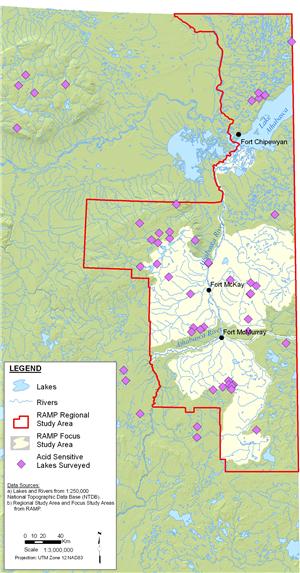Acid Sensitive Lakes
Depending on the geology and chemistry of the surrounding landscape, lakes, rivers, wetlands, and soils can be sensitive to acidification resulting from the deposition of acidifying materials over time. These acidifying materials can include air emissions of nitrous or sulphur oxides from oil sands and other industrial projects. Deposition of these substances in excess of a lake’s ability to neutralize (or buffer) the acidifying material can lead to changes in pH and other aspects of water quality that can significantly affect aquatic life. The RAMP Acid Sensitive Lakes component monitors water chemistry in numerous regional lakes that have been identified as susceptible to acidification.
The objectives of the Acid Sensitive Lakes component are to:
- Monitor acid sensitive lakes to detect effects of acidifying materials on water quality and lake biology, and to identify and assess cumulative effects and regional trends.
- Collect baseline data to establish the range of natural variability in lake chemistry and biology.
- Collect data against which predictions documented in oil sands EIAs can be assessed.
- Quantify and document the sensitivity of individual lakes to acidification.
RAMP samples approximately fifty regional lakes each year in late summer-fall. Water samples are collected from the euphotic zone (upper water layer exposed to sunlight) and sent to an analytical laboratory for analysis of the following variables:
- Conventional variables—pH, turbidity, colour, total suspended solids, total dissolved solids, dissolved organic carbon, dissolved inorganic carbon, conductivity, total alkalinity, and Gran alkalinity;
- Ions—bicarbonate, Gran bicarbonate, chloride, sulphate, calcium, potassium, sodium, and magnesium;
- Nutrients—total dissolved nitrogen, ammonia, nitrate+nitrite, total Kjeldahl nitrogen, total nitrogen, total phosphorus, and total dissolved phosphorus;
- Chlorophyll-a; and
- Metals, including iron and silicon.
The measurement endpoints for the Acid Sensitive Lakes component include measures of acidity and ion balance, or variables linked to changes in these factors. The measurement endpoints include pH, Gran alkalinity, base cation concentrations, nitrate+nitrite, sulphate, dissolved organic carbon, and dissolved aluminum. Impacts from acid deposition are assessed by comparing measured data to the range of natural variability, with significant changes beyond natural conditions identified as potential impacts.
For additional information on sampling and analytical methods used by the RAMP Acid Sensitive Lakes component, please refer to the relevant sections of the RAMP Technical Design and Rationale report and the annual RAMP technical reports (see Monitoring Results).









